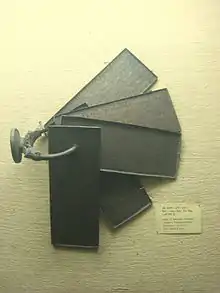Telugu-Kannada alphabet
The Telugu-Kannada alphabet is a writing system used in southern India. Despite, some differences, the scripts used for the Telugu and Kannada languages remain quite similar.
| Telugu-Kannada alphabet Old Kannada script | |
|---|---|
 Copper plate inscriptions in Kannada-Telugu script | |
| Type | |
| Languages | Kannada Telugu Tulu Konkani Sanskrit |
Time period | 7th century –14th century[1][2] |
Parent systems | Proto-Sinaitic script[a]
|
Child systems | Kannada script, Telugu script |
Sister systems | Pyu |
[a] The Semitic origin of the Brahmic scripts is not universally agreed upon. | |
| Brahmic scripts |
|---|
| The Brahmic script and its descendants |
History
The Dravidian family comprises about 73 languages including Telugu, Kannada, Tamil and Malayalam. Satavahanas introduced the Brahmi to present-day Telugu and Kannada speaking regions. Bhattiprolu script introduced by the Satavahanas gave rise to the Kadamba script.[5][6][7] During the 5th to 7th centuries CE the early Bādāmi Chālukyās and Early Banavasi Kadambās used an early form of the Kannada script in inscriptions, called the Kadamba script.[8] The Kadamba script evolved into the Telugu-Kannada script, which was used between the 7th and 11th centuries CE.[1]
Kannada became a written language ahead of Telugu. Both Kannada and Telugu produced poetry during the eighth century. Full-fledged literary works in Kannada appeared in the ninth century, two centuries before they became available in Telugu.[9][10][11] The earliest known Telugu inscriptions date to the 6th century CE. Telugu poetry began to appear in the 11th century.[12] Telugu writers waited until the 11th century because of socio-political factors (royal patronage, the influence of Buddhism and Jainism).[13]
Between 1100 CE and 1400 CE the Kannada and Telugu scripts separated from the Telugu-Kannada script. Satavahanas and Chalukyas influenced the similarities between Telugu and Kannada scripts.[14]
See also
External links
- Evolution of Telugu Character Graphs
- Salankayana Telugu-Kannada script
- Kadamba -> Old-Kannada -> Kannada and Telugu script
- Copper plates in Telugu-Kannada script
- Brahmi -> Kadamba -> Old Kannada -> Telugu-Kannada scripts
Inscriptions in Kannada-Telugu script
- Kakatiya period Telugu-Kannada inscription by poet Nrusimha Rushi dating between 1295 and 1325 found on hillocks near Urs on the outskirts of Warangal.
- 13th-century Kakatiya era Bayyaram stone inscription found in Bayyaram mandal Andhra Pradesh.
Evolution and Development of Kannada-Telugu script
References
- Diringer, David (1948). Alphabet a key to the history of mankind. p. 381.
- Salomon, Richard (1998). Indian Epigraphy. p. 41.
- Handbook of Literacy in Akshara Orthography, R. Malatesha Joshi, Catherine McBride(2019),p.29
- Salomon 1999, p. 35
- The Blackwell Encyclopedia of Writing Systems by Florian Coulmas, p. 228; Salomon (1998), p. 40.
- Handbook of Literacy in Akshara Orthography, R. Malatesha Joshi, Catherine McBride(2019),p.29
- Salomon 1999, p. 35
- "Epigraphical Studies in India - Sanskrit and Dravidian, Scripts used in India, Scripts Abroad". Retrieved 2013-09-06.
- Kumar, R. Krishna (2017-11-25). "Kavirajamarga, a tour with a difference". The Hindu. ISSN 0971-751X. Retrieved 2019-01-22.
- "Kavirajamarga", Wikipedia, 2019-01-21, retrieved 2019-01-22
- "Aadi Kavi Nannaya's brilliant translation of the Mahabharata". The Hans India. 2014-11-12. Retrieved 2019-01-22.
- "A sampler of the world's writing systems" (PDF). J. Marshall Unger Department of East Asian Languages & Literatures -The Ohio State University. Retrieved 2013-09-06.
- "Origins of Telugu Script". Retrieved 2013-09-03.
- "Evolution of Telugu Character Graphs". Retrieved 2013-07-22.